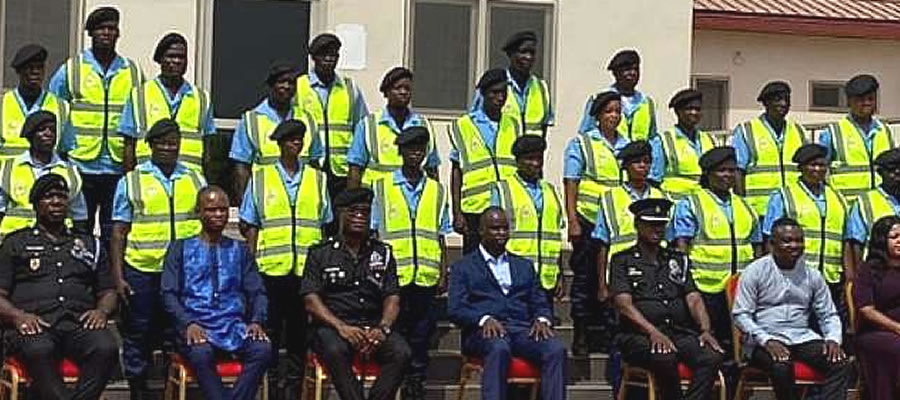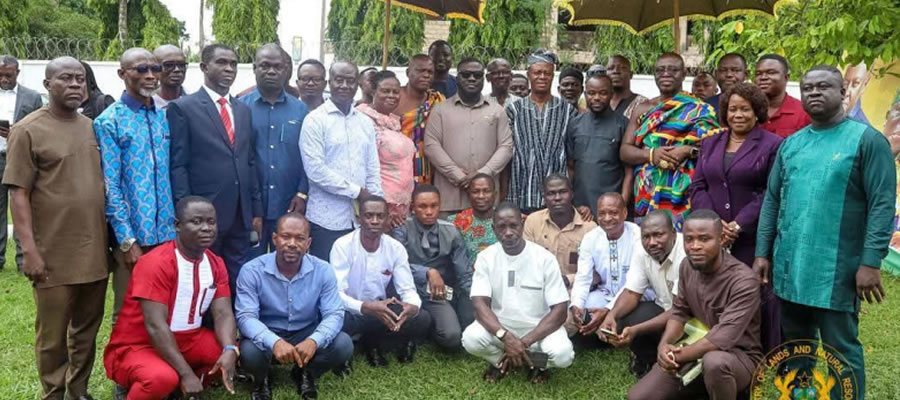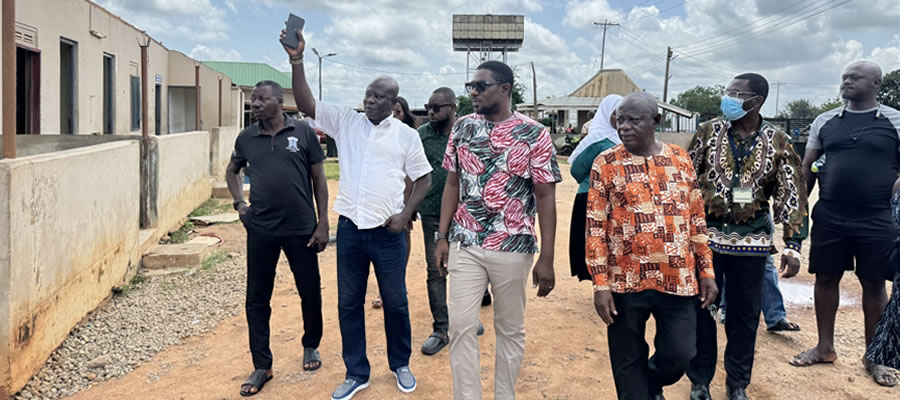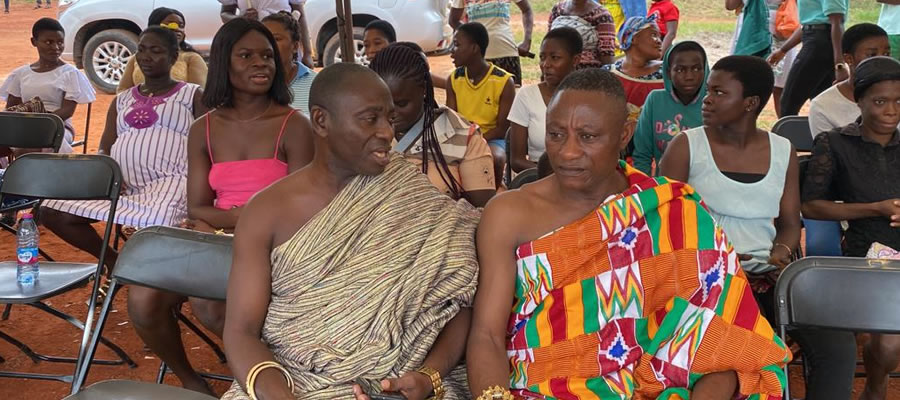

Location and Size
The Atwima Nwabiagya District lies approximately between latitude 6o 32’N and 6o 75’N and between longitude 1o 45’ and 2o 00’ West. It is one of the 30 political and administrative districts in Ashanti Region.
The district is situated in the western part of the region and shares common boundaries with Ahafo Ano South and Atwima Mponua Districts (to the West), Offinso Municipal (to the North), Amansie–West and Atwima Kwanwoma Districts (to the South), Kumasi Metropolis and Afigya Kwabre Districts (to the East). It covers an estimated area of 294.84 sq km. The district capital is Nkawie.
The main highway corridor from the Ashanti Region to the Western Region goes through our district.
Topography and Drainage
The district has an undulating topography. The lands have average heights of about 77 metres above sea level. The high lands have gentle to steep slopes. The highest points in the district can be found in the Barekese and Tabere areas. There are a number of wider valleys with no evidence of stream flow. These valleys provide opportunities for rice, sugarcane and vegetable cultivation.
The Offin and Owabi are the main rivers which drain the surface area of the district. Two major dams, Owabi and Barekese have been constructed across the Owabi and the Offin rivers respectively. These dams supply pipe borne water to the residents of Kumasi and its environs, including some settlements in the district.
Farming activities are carried out close to the banks of some of the rivers and streams in the district, which results in eutrophication and siltation of the rivers required to protect and conserve vegetation of the district, especially around water bodies.
Climate
The District lies within the wet semi-equatorial zone marked by double maximum rainfall ranging between 170cm and 185cm per annum. The major rainfall season is from Mid-March to July and minor season is between September and mid-November. Rainfall in the district is not distributed throughout the year. It is also not very reliable. It is therefore not safe to entirely practice rain fed agriculture. Agriculture within the district must incorporate soil and water conservation measures to ensure all year crop cultivation and good yield.
Temperature is fairly uniform ranging between 27ºC (August) and 31ºC (March). Mean relative humidity is between 87 and 91 percent. The lowest relative humidity usually occurs in February/April.
Vegetation
The vegetation found in the district is predominantly the semi-deciduous type. The vegetation type has largely been disturbed by human activities (logging, farming, bush fires etc), thus, depriving it of its original valuable tree species (eg odum, sapale), fauna and other forest products.
There are some pockets of forest reserves available in the district. These include the Owabi Water Works Forest Reserves and Barekese Water Works Forest Reserve, which serve as water shed protection for the Ofin and Owabi rivers. In addition part of the Gyemena Forest Reserve is located in the district.
These forest reserves have been encroached upon by farmers, sand winners and illegal chain saw operators. These practices continue to threaten the lives of the Offin and Owabi Rivers, and the Barekese and Owabi reservoirs. Public education, proper enforcements of existing laws and other conservation interventions are visible evidence of the adverse effects of climate change in the Atwima Nwabiagya District. These include changes in rainfall patterns, storms, altered patterns of agriculture and associated crop failures, intermittent flow of streams, and increased cases of diseases (especially malaria), among others. These changes are threats to the achievement of the development priorities of the district.
There is therefore the need to reduce the vulnerability of natural and human systems to climate change effects, and also reduce the emission of greenhouse gases or enhance the removal of these gases from the atmosphere. Development effort of the district must therefore be compatible with this aim. Reduction in indiscriminate solid and liquid waste disposal, improvement in drainage systems, reduction in haphazard erection of physical structures, reduction in deforestation and degradation of water bodies would go a long way to enhance natural and human adaptation to climate change effects.
Soils
The district is underlain by the Lower Birimian rocks, which consist of phyllites, greywaches, achists and gneiss, and the Cape Coast Granite. Both the Lower Birimian and the Cape Coast Granite are of considerable economic importance since they do bear Gold, and good clay deposit for ceramics and brick making. The Cape Coast Granite is a good potential for the building and road construction industry.
The District Assembly should continue to provide conducive environment for the full-scale and sustainable exploitation of these rocks, which are mostly found around Asakraka, Nerebehi, Mfensi, Tabere, Ntensre and Barekese, to create jobs and also provide sources of revenue for the district’s development.
The predominant soils in the district are the Kumasi-Asuansi/Nta-Ofin Compound Associations and the Bekwai- Nzema/Oda Complex Associations. They are suitable for cultivation of tree and arable crops such as cocoa, citrus, oil palm, mangoes, guava, avocado, maize, cassava, yams, cocoyam, plantain, pawpaw, groundnuts pineapple and ginger. The valley bottom soils are good for the cultivation of rice, sugarcane and vegetable.
Residential activities and sand winning have currently taken most of these good agriculture lands. Proper land use planning and zoning are required to protect soils which are suitable for agriculture.
Geology and Minerals
The district is underlain by the Lower Birimian rocks, which consist of phyllites, greywaches, achists and gneiss, and the Cape Coast Granite. Both the Lower Birimian and the Cape Coast Granite are not of considerable economic importance since they do not bear Gold and Bauxite. However, the rocks (Especially the Lower Birimian) consist of good clay deposit. The Cape Coast Granite is a good potential for the Construction Industry.
It is the hope of the District Assembly that the full-scale exploitation of these rocks, which are mostly found around Tabere and Barekese, will create jobs in the district and also provide the much-needed revenue for the district’s development.
The District’s proximity to the Kumasi Metropolis has a number of advantages, which requires attention. These include the following:
Some of the settlements serves as dormitory to Kumasi and therefore receives fast rate of physical development for residential and commercial purposes. As a result land value in these areas has increased thereby increasing the incomes of landowners.
The increasing rate of property development in these areas is a potential for increased revenue generation by the District Assembly.
Kumasi is a big potential market for variety of agricultural produce. Atwima Nwabiagya is an agrarian district and should therefore take advantage of this potential market to diversify and increase production.
There are also some disadvantages associated with the location of the district. These include the following:
Pressure on land and its associate high cost
Good Agricultural lands are gradually being lost to urban development
The district is a receptor of the spill over of the Metropolitan crimes and other social vices
Increased level of waste generation
Increased unemployment for the unskilled labour due to loss of Agricultural lands for residential and ancillary physical development.
Measures are therefore required to exploit the advantages and to manage the disadvantages associated with the district’s location
Date Created : 11/28/2017 4:31:24 AM












 facebook
facebook
 twitter
twitter
 Youtube
Youtube
 +233 593 831 280
+233 593 831 280 0800 430 430
0800 430 430 GPS: GE-231-4383
GPS: GE-231-4383 info@ghanadistricts.com
info@ghanadistricts.com Box GP1044, Accra, Ghana
Box GP1044, Accra, Ghana